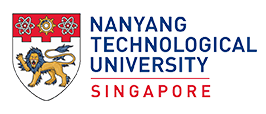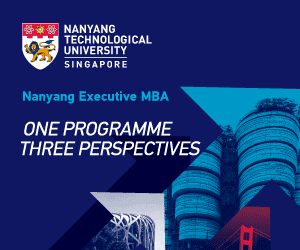Graduate Studies Blog

NANYANG EXECUTIVE MBA
Meet the Japanese Leaders Driving Change with a Global Mindset and a Nanyang EMBA
Volatile geopolitics, breakneck artificial intelligence (AI) development, supply chains in crisis. Just by the headlines, doing business around the globe isn’t getting any easier – and Japanese leaders are right in the thick of it.
Yukito Fujita and Yuta Yuasa understand the challenges Japanese executives face, perhaps better than most. Yukito works at Google Japan as Head of the Manufacturing and Industrial Division; Yuta works at NTT Data Malaysia as its Digital Transformation (DX) Business Director. They’re both corporate leaders at the intersection of global markets and new technology – and both Nanyang Executive MBA participants (Yukito from the Class of 2025; Yuta from the Class of 2026).
As Japanese executives, Yukito and Yuta tap the core strengths of the corporate culture that shaped them: a commitment to “kaizen”-driven quality, consensus-based leadership, and a thoughtful approach to tech adoption.
They’ve also strengthened these foundations with insights gained from the Nanyang EMBA: a programme built to sharpen global thinking, cultural dexterity, and change leadership at the executive level.
How do they use this combination of home-grown values and EMBA-derived insights to navigate the unique pressures confronting Japanese business leaders today – and stay competitive in today’s high-speed, high-stakes market?
To understand how this plays out in practice, we explore three key challenges facing Japanese business leaders – and how Yukito and Yuta are working to overcome them.
1. Bridging the gap with Cultural Intelligence
When Yuta moved to NTT Data’s Malaysia office, he was surprised by its emphasis on short-term results. “Japanese businesses traditionally focus on long-term relationships and strategic growth resulting from sustained partnerships,” he explains.
For Japanese leaders, these encounters can upend unconscious but deeply-rooted assumptions. They might attempt to carry on with their usual leadership styles – but as Yuta warns, “directly applying the same methods in regions like Malaysia presents challenges due to differing business environments.”
Both Yukito and Yuta believe overseas assignments are uncommon among Japanese in corporate businesses. “Less than 10% of Japanese businesspeople are familiar with international business,” Yukito explains.
“Almost everyone faces challenges – especially with language, which is very important for exchanging industry information,” Yukito tells us. “Some businesspeople aren’t used to searching for information globally; the common data source is mostly in English, so it needs to be translated.”
Yuta adds: “Executives need international exposure to grow,” he says, which will be increasingly relevant with global M&A on the rise. “Bridging cultural differences and ensuring alignment with corporate values requires continuous effort.”

Cultural Intelligence (CQ) insights learned at Nanyang EMBA gave Yuta and Yukito a more effective playbook for collaborating across large cultural gaps. Yukito wonders aloud if CQ might have shortened the timeline of Nippon Steel acquisition of US Steel, which had been delayed by the American labour movement’s opposition to the deal. “You can’t solve that conflict without understanding cultural differences,” Yukito explains.
These situations might welcome Japanese consensus-building as a way to bridge cultural gaps. Yukito studied this style of governance at the Nanyang EMBA: “In Japan, we have a consensus culture – true top-down culture is more typical of American companies.”
2. Adapting to rapid tech-driven change
Japanese conglomerates are under great pressure to respond to global business demands. Consider the manufacturing sector, Yukito’s own domain: “They face challenges transforming beyond traditional manufacturing,” he explains. “That’s my role: helping them address those challenges.”
Complete reinvention is not out of the question. “They must shift to new business models or develop new capabilities for their customers,” Yukito explains, pointing to two recent examples: “Sony used to be a manufacturer, but now it’s a media company; Fujitsu is transforming into a consulting business like Accenture.”
Others are exploring AI’s potential in enabling these shifts. “Japanese industries are advanced in this – they recognise the advantages of AI,” Yukito says. He cites a Japanese company experimenting with a “CEO-AI” that acts as a proxy in internal discussions with employees. “The CEO is busy, so he can’t reply to every employee directly,” explains Yukito. “The CEO-AI is very useful – up to 80% of its responses are accurate.”
However, compared to the swift, sometimes chaotic pace of tech adoption abroad, Japan’s trajectory feels more intentional and methodical. Part of this is down to a capability gap: “We understand AI, but it’s difficult to adapt to clients’ business processes,” Yukito says. “We need implementation partners with deep industry knowledge.”
(Or, at the very least, leaders who can “connect the dots” between business and technology, which both Yuta and Yukito represent – thanks to Nanyang Business School’s interdisciplinary ethos that fuses business skills with digital innovation.)
Secondly, rapid prototyping and iteration – hallmarks of emerging tech – don’t always align with Japan’s cultural focus on reliability and minimising risk. “When I managed a major Japanese bank’s core systems, even a one-minute outage was unacceptable,” Yuta explains, indicating a culturally conservative approach to deployment and scale: “Most top management test GenAI technology in the back office first, not externally.”
The flipside of this is Japan’s “kaizen” mindset of small, incremental changes that achieve long-term benefits. Yuta believes “kaizen” underpins their office’s service delivery philosophy: “At NTT Data, we don’t necessarily have any super-special solution, but we can leverage many solutions and develop systems,” he says. “We can keep core systems running without failures.”
3. Upgrading leadership skills
Like many in Japan, Yuta and Yukito rose through the ranks via internal promotion. Still, they’re not without reservations about the system.
“Because internal promotion is so common, department heads are not always good at accounting or strategy because of backgrounds in, say, engineering,” Yuta explains, recalling his own experience as an executive working in NTT Data’s corporate strategy office. Asked to create a corporate midterm strategy, Yuta hesitated.
“My background is in engineering – at that time, I wasn’t good at strategy,” he recalls. “If I had joined the Nanyang EMBA before corporate strategy, I would have been more comfortable — I’d be looking at every aspect and implementing frameworks I would have learned.”
Yuta is grateful that the Nanyang EMBA gave him a “driver’s license” for grasping the full mechanics of business leadership. “Other countries’ top management have MBAs – they are good at accounting, strategy, and many areas, not just one,” he explains. “It sets a global standard on how to manage a company and allocate resources correctly.”
Yukito, for his part, credits the Nanyang EMBA’s overseas segments for his intense exposure to insights from global centres of business. “We got a lot of information from China and the US, and of course, Singapore,” he explains.
In the segment at the University of California (Berkeley), Yukito was challenged to critically reassess his leadership style. “I always aspired to be a visionary leader, but a 360-degree survey at Berkeley showed that I’m actually a very directive leader – not a visionary one,” he recalled.
Sitting down with a Nanyang EMBA professor, Yukito realised he had a rare chance to turn insight into action.
“They recommended that I first build coaching skills as a first step – to better understand my counterparts, and to learn how to influence or convince them of my ideas.”

Ready to lead the world
Japanese executives are natural leaders on the world stage – they’re grounded in quality and long-term thinking, yet ready to adapt to global change and rapid tech shifts.
Nanyang EMBA alumni like Yukito Fujita and Yuta Yuasa demonstrate how innate cultural strengths can evolve through international experience and fresh perspectives delivered by the Nanyang EMBA experience.
Yukito and Yuta’s global journey began with the Nanyang EMBA. Yours can, too – visit the Nanyang EMBA website or download the brochure to learn more about the programme and available funding options.
About the Nanyang Executive MBA
The Nanyang EMBA provides accomplished leaders with classroom knowledge and hands-on business experience to synergize technical expertise with business knowledge. It is especially relevant in a fast-changing technological global landscape.
Its part-time format integrates with work commitments, allowing focused time for work and EMBA responsibilities.
The flexible programme is 13-month long with the option to extend to two years to allow for exigencies.
Visit the Nanyang EMBA website or download the brochure to learn more about the programme and available funding options.
Download the Nanyang Executive MBA brochure
Click here to learn more about the Nanyang Executive MBA programme or contact us at execmba@ntu.edu.sg.


